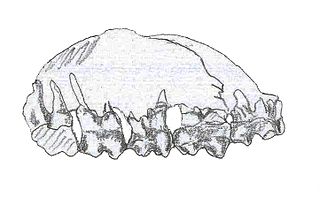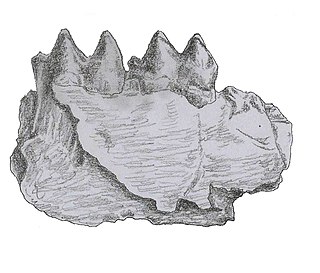
The Pipidae are a family of primitive, tongueless frogs. There are 41 species in the family, found in tropical South America and sub-Saharan Africa.

Trigonostylops is an extinct genus of South American meridiungulatan ungulate, from the Late Paleocene to Late Eocene of South America and Antarctica. It is the only member of the family Trigonostylopidae.
The South American land mammal ages (SALMA) establish a geologic timescale for prehistoric South American fauna beginning 64.5 Ma during the Paleocene and continuing through to the Late Pleistocene. These periods are referred to as ages, stages, or intervals and were established using geographic place names where fossil materials where obtained.
The Mustersan age is a period of geologic time within the Eocene epoch of the Paleogene, used more specifically within the South American land mammal age (SALMA) classification. It follows the Casamayoran and precedes the Divisaderan age.
The Divisaderan age is a South American land mammal age, covering a period of geologic time within the Middle and Late Eocene epochs of the Paleogene. It follows the Mustersan age and is followed by the Tinguirirican age.
The Tinguirirican age is a period of geologic time within the Late Eocene and Early Oligocene epochs of the Paleogene, used more specifically within the SALMA classification in South America. It follows the Divisaderan and precedes the Deseadan age.
The Deseadan age is a period of geologic time within the Oligocene epoch of the Paleogene to the Early Miocene epoch of the Neogene, used more specifically within the SALMA classification of South America. It follows the Tinguirirican and precedes the Colhuehuapian age.
The Laventan age is a period of geologic time within the Middle Miocene epoch of the Neogene, used more specifically within the SALMA classification in South America. It follows the Colloncuran and precedes the Mayoan age.
The Mayoan age is a period of geologic time from 11.8 to 10 Ma, within the Middle to Late Miocene epoch of the Neogene, used more specifically within the SALMA classification in South America. It follows the Laventan and precedes the Chasicoan age.
Canaanimys is an extinct genus of caviomorph known from the Loreto of Peru.
This paleomammalogy list records new fossil mammal taxa that were described during the year 2012, as well as notes other significant paleomammalogy discoveries and events which occurred during that year.

The Pebas Formation is a lithostratigraphic unit of Miocene age, found in western Amazonia. The formation extends over 1,000,000 square kilometres (390,000 sq mi), including parts of Brazil, Peru, Ecuador and Colombia. It is interpreted as representing the deposits of a lake or series of lakes, formed within the foreland basin of the Andes mountain belt. It is known for its abundant fossil ostracods and molluscs and an unusually diverse group of crocodylians.
Mystacodon is a genus of toothed baleen whale from the Late Eocene Yumaque Member of Paracas Formation of the Pisco Basin in southwestern Peru. It is the oldest known baleen whale, and was probably a suction feeder of small prey on the seafloor.

Colombitherium is an extinct mammal from Late Eocene Colombia. It has originally been assigned to the order Pyrotheria and the family Colombitheriidae, although a later detailed analysis of the fossil questions that classification. A fossil jawbone of approximately 9 centimetres (3.5 in) length of Colombitherium has been found by Texas Petroleum in 1945, in the Upper Eocene strata of the middle Gualanday Group in the department of Tolima, Central Ranges of the Colombian Andes.

Miocochilius is an extinct genus of small notoungulate mammals (typotheres) native to South America. The genus lived during the Middle Miocene epoch. The genus contains two described species, the type species M. anomopodus described in 1953 by Ruben Arthur Stirton and M. federicoi, described and included in the genus by Darin A. Croft.
Canaanimico is an extinct genus of medium-sized New World monkeys from the Late Oligocene fossiliferous fluvio-lacustrine Chambira Formation of the Ucayali Basin in Amazonian Peru. The genus was described by Marivaux et al. in 2016 and the type species is C. amazonensis.
The Agua de la Piedra Formation is a Late Oligocene geologic formation of the Malargüe Group that crops out in the southernmost Precordillera and northernmost Neuquén Basin in southern Mendoza Province, Argentina.

Griphodon is an extinct genus of mammals, belonging to the order Pyrotheria. It lived during the Middle Eocene, in what is now Peru.





